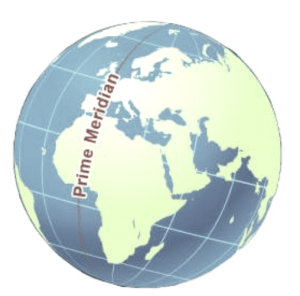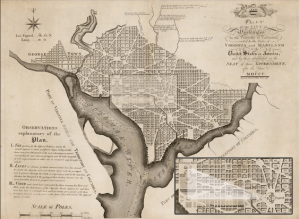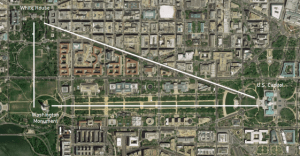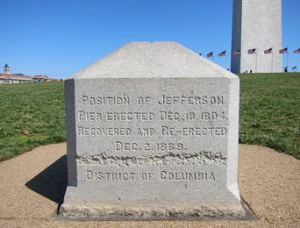The Jefferson Pier
![jefferson a large clock tower in the middle of a field with Washington Monument in the background]()
Welcome to Weird Memorials of Washington, a monthly blog post that examines the Capital’s odd and little-known monuments, memorials, and landmarks. This month, we’ll discuss the Jefferson Pier — part of our National Mall: Monuments and Memorials Walking Tour.
The Washington Monument is one of the District of Columbia’s most recognizable and iconic structures. Towering 555 feet above the city, this massive marble obelisk was once the tallest structure in the world. But, sitting in its long shadow, is one of the oddest and most obscure little landmarks on the National Mall.
A New Meridian for a New Nation
The Jefferson Pier, a three foot tall stone marker, stands due west of the Washington Monument in the middle of a grassy field. This diminutive structure, more a monument to Thomas Jefferson’s ego than anything else, marks what our Third President hoped would be the center of the world.
As the principal author of the Declaration of Independence, Thomas Jefferson was determined to show complete social, political, and scientific autonomy from Great Britain after the Revolutionary War. At the time, England, and its colonies, defined the prime meridian— the North-South line that runs along the circumference of the globe, marking 0° longitude– at the Royal Observatory in London, England.

Unlike the equator, which is determined by the Earth’s rotation, the location of the prime meridian is scientifically arbitrary. Thus, in an attempt to further distance the United States from its former rulers, in 1793 Jefferson suggested a new prime meridian, running through the center of our new capital in Washington DC.
 Sacred Geometry in Washington
Sacred Geometry in Washington
Jefferson decided to place the center of the meridian at the corner of a right triangle connecting Washington’s most important landmarks: the President’s Mansion (the White House), Congress House (the Capitol Building), and the proposed location of a monument to George Washington, as envisioned by city planner Pierre L’Enfant.

A modern bird’s eye view of Washington DC, however, reveals an unfortunate but necessary divergence from L’Enfant’s plan. The original site selected for the Washington Monument, where the Jefferson Pier is located, was deemed unfit for a towering obelisk. In 1848, when engineers began excavating for the foundations of the monument, they discovered the soil was too moist and unstable to support such a massive structure. The Washington Monument site was shifted to higher ground xx feet to the east, and Pierre L’Enfant’s city plan was forever altered. The Jefferson Pier, rather than the Washington Monument, now sits at the site.
Obscure and Obsolete
The stone pier currently marking the location of Jefferson’s meridian is, of course, not the original. The wooden stake placed by Jefferson in 1793, and the stone replacement erected in 1804, are gone. The latter was accidentally removed by the Army Corps of Engineers during the construction of the Washington Monument in 1874, leaving just 20 inches of foundation buried underground.
The significance of the pier was further undermined in 1884, when at the International Meridian Conference, hosted in Washington DC by President Chester Arthur, the United States agreed to accept the Greenwich Meridian as the prime meridian.
Despite the pier’s total irrelevance, a new marker was installed in 1889 with an explanatory inscription reading:

Position of Jefferson
Pier erected December 18, 1804
Recovered and Re-erected December 2, 1889
Being the centre point of theDistrict of Columbia
Modern visitors will notice that the fifth line of the inscription, “being the centre point of the,” has been chiseled out. Though the prime meridian never ran through the Jefferson Pier, the stone was used as a zero marker, marking the point from which official distances are determined in Washington DC. However, in 1920 a new zero marker was installed on the south side of the White House, rendering the inscription on the pier misleading and obsolete.
We hope you’ll join us on our National Mall: Monuments and Memorials tour to visit the Jefferson Pier, Washington Monument, and lots more sights, both iconic and obscure!



 Sacred Geometry in Washington
Sacred Geometry in Washington
